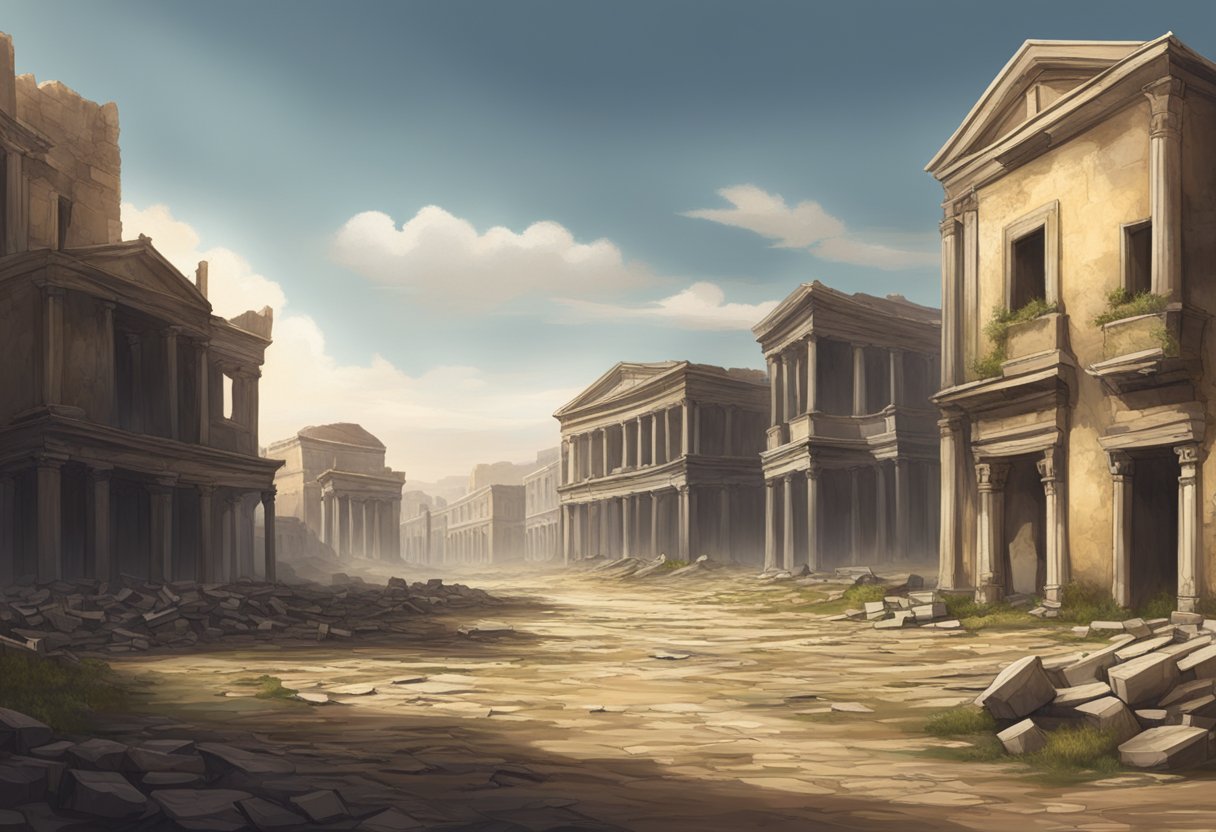The Antonine Plague was a devastating epidemic that struck the Roman Empire during the reign of Emperor Marcus Aurelius. Its symptoms included high fever, diarrhea, skin eruptions, and sore throat. These symptoms have led many modern scholars to speculate that the disease might have been smallpox or measles.

The plague emerged in 165 AD and lasted until approximately 180 AD, coinciding with the Roman Empire’s height of economic prosperity and territorial expansion.
Reverberating through the empire’s vast regions, the Antonine Plague had far-reaching effects on its military strength, political stability, and economic vigor. Not only did it claim the lives of emperors including Lucius Verus and possibly Marcus Aurelius himself, but it also intensified the pressures on an empire struggling to maintain its boundaries against external threats.
The exact mortality rate of the Antonine Plague is unknown, but it is clear that it was significant enough to contribute to a demographic shift that would have long-lasting implications for the Roman Empire.
Key Takeaways
- The Antonine Plague was a significant health crisis during the Roman Empire’s peak, with symptoms resembling smallpox or measles.
- It weakened the Roman military, contributed to political instability, and had a deleterious economic impact.
- The series of outbreaks over 15 years led to a demographic shift with profound long-term effects on Rome’s society and infrastructure.
Historical Context
The Antonine Plague, also known as the Plague of Galen, was a devastating epidemic that affected the Roman Empire from around AD 165 to 180. This context provides insight into the plague’s origins, its impact on Roman military forces, and the broader economic and social repercussions for the empire.
Origin and Spread of the Antonine Plague
Origin: Historians believe that the Antonine Plague may have originated in China or elsewhere in Asia. It was possibly brought to the Roman Empire by soldiers returning from campaigns in the Near East.
- Silk Road & Trade Routes: The extensive network of trade routes, including the renowned Silk Road, facilitated the spread not only of goods but also of diseases between distant regions like China and the Roman Empire.
- Seleucia Incident: The contagion possibly entered the Roman territories through the Mesopotamian city of Seleucia, which was captured by the imperial forces led by co-emperor Lucius Verus.
Impact on the Roman Military
Manpower Loss: The Antonine Plague had a profound impact on the Roman military, significantly reducing its manpower due to the high mortality rates experienced within the legions.
- Military Campaigns: The reduced numbers adversely affected military campaigns, compromising the empire’s defensive and offensive capabilities during a period of frequent skirmishing on the empire’s borders.
Economic and Social Consequences
Trade & Agriculture Disruption: The epidemic crippled economic activity, disrupting trade and agriculture. The scarcity of labor led to a decline in crop production and increased the cost of goods.
- Population Decline: A sharp decline in population destabilized societal structures, exacerbating the crisis within urban centers and rural communities alike.
Despair & Disarray: Social consequences included widespread despair and disarray, further weakening the cohesion and morale of Roman society. Roman citizens, as well as slaves and non-citizens, were all impacted, although the exact toll remains uncertain.
Historian Galen’s Accounts: The works of Galen, a prominent physician and philosopher, provide invaluable details on the symptoms and course of the plague, offering a key primary source for understanding this period of Roman history.
The Plague’s Characteristics
The Antonine Plague, a devastating epidemic that impacted the Roman Empire, exhibited specific symptoms that allowed for its classification and study. Its characteristics were methodically documented by physicians of the time.
Symptoms and Diagnosis
Patients with the Antonine Plague typically presented with fever, skin eruptions resembling smallpox, diarrhea, and coughing. These manifestations led contemporary physicians to make a clinical diagnosis, although the tools and methods available at the time were less advanced than what modern medicine would offer.
Galen’s Observations
Galen, a prominent Roman physician, provided detailed descriptions of the illness, noting the sudden onset of fever and the appearance of skin eruptions. His accounts represent one of the earliest medical descriptions of what many historians now believe may have been an epidemic of smallpox.
Comparisons to Other Epidemics
When contrasted with other historical epidemics, the Antonine Plague shares similarities with those caused by viral hemorrhagic fevers and smallpox. However, without definitive laboratory confirmation, such comparisons remain speculative, though they provide a foundation for understanding the disease’s pandemic impact on the Roman population.
Key Figures
The Antonine Plague, a devastating epidemic, is closely associated with two pivotal figures from ancient history: Emperor Marcus Aurelius and Galen the Physician. Their roles during this catastrophic event illustrate the intertwining of leadership and medical knowledge in the face of a crisis.
Emperor Marcus Aurelius
Marcus Aurelius, the Philosopher Emperor of Rome, is remembered for his stoic philosophy and leadership during the Antonine Plague which struck the Roman Empire from 165 to 180 CE. As both Emperor and a key figure during the plague, he faced the challenge of maintaining stability and morale. Co-Emperor Lucius Verus, his adoptive brother, shared the throne but it was Marcus Aurelius’s wisdom and philosophical approach that left an enduring mark on history.
Galen, the Physician
Galen of Pergamon served as a prominent physician during the Antonine Plague and his medical texts would influence healthcare for centuries. He is often associated with the diagnosis and treatment of the plague, observing its symptoms and course with detail. Outside of these direct contributions, Galen’s relationship with other key figures, such as the orator Aelius Aristides, expanded the context of medicine in this era.
Cultural and Religious Impact

The Antonine Plague significantly altered the landscape of Roman religious practices and societal norms, catalyzing shifts in worship and reinforcing the notion of divine vengeance.
Perceptions of Divine Wrath and Punishment
The onslaught of the Antonine Plague was interpreted by many Romans as an expression of divine wrath, with gods seen as dispensing punishment for societal transgressions. This belief in supernatural retribution pervaded Roman culture, influencing both private and public responses to the epidemic.
Effect on Roman Religion and Society
As Roman society grappled with the devastation of the Antonine Plague, a marked shift in religious dynamics occurred. Traditional polytheistic worship faced challenges as the population sought solace and explanations for the catastrophe.
This tumultuous period saw a rise in the influence of Christianity, as it provided an alternative framework of meaning and morality during this era of crisis. The turmoil further led to cultural transformations and the marginalization of traditional religious practices, as people looked for a beacon of hope amidst the despair, sometimes resulting in persecutions of those holding alternative beliefs.
Roman soldiers, often the carriers of the disease to distant parts of the Empire, inadvertently became agents of cultural change, affecting Roman society at all levels.
Military and Political Outcomes
The Antonine Plague had profound repercussions, particularly on the military might and the political landscape of the Roman Empire, leading to substantial manpower shortages and triggering a range of state responses.
Military Setbacks and Losses
The Roman military, crucial to the empire’s stability and expansion, faced severe manpower shortages due to the Antonine Plague. Battalions were particularly hard-hit in regions such as Egypt and the Rhine, where the plague disrupted military campaigns and border defenses.
The depletion of soldiers weakened Rome’s response to external threats and internal security challenges.
Manpower Shortages: The virus drastically reduced the pool of individuals available for military service, leading to a depletion of troops at a time when the Roman Empire faced mounting pressures on its frontiers.
Political Responses to the Crisis
The political climate in Rome was significantly affected by the Antonine Plague. The central authority had to navigate the turmoil, balancing resources between maintaining state functionality and addressing the health crisis.
Demographic and Economic Effects

The Antonine Plague had profound demographic and economic consequences for the Roman Empire, leading to significant population decline and a shortage of labor that disrupted the economic landscape.
Population Decline and Mortality Rates
With the outbreak of the Antonine Plague, the death toll rose sharply. Estimates suggest a significant portion of the population succumbed to the disease. Some regions experienced more severe losses than others. This demographic shift led to a decrease in the number of available workers.
Shortage of Workers and Economic Hardship
The plague not only decimated the population but also led to a shortage of labor. The workforce across various sectors shrank, which drove up wages as employers competed for the reduced number of workers. This sudden shift disproportionately affected the economy. Sectors reliant on manual labor, including those dependent on slaves, struggled to maintain productivity.
Long-Term Impact on the Roman World
The Antonine Plague significantly contributed to the destabilization of the Roman Empire. This led to a chain of events that altered its trajectory and contributed to its fall. This pestilence undermined the prosperity achieved during the Pax Romana and challenged the governing efficiency heralded by the Five Good Emperors.
Influence on the Empire’s Decline
The Antonine Plague, which struck during the reign of Marcus Aurelius, is often seen as a catalyst that expedited the Decline of the Roman Empire. With a significant portion of the population decimated, including the military and labor force, the Empire faced critical challenges. The loss of personnel weakened Rome’s ability to defend its borders and maintain the public works so crucial for its cities. This depletion of manpower had a long-reaching impact on Roman Power and the Empire’s ability to project its strength and maintain order.
Transition and Transformation of the Roman State
Following the plague, the Roman State underwent both a Transition and Transformation. The economic turmoil persisted, with a contraction in agricultural production and a shortage of labor prompting significant changes in social and fiscal policies. The Emperor had to adopt emergency measures to stabilize the situation, leading to transformations in the structure of the Roman State. The administration grew more bureaucratic, and power became increasingly centralized, foreshadowing the eventual split between East and West as well as the collapse of the Western Empire. The Fall of the Western Roman Empire can thus be partly attributed to the systemic shocks delivered by the Antonine Plague and the subsequent adaptations that were unable to reverse the tide.
Frequently Asked Questions

This section addresses some of the most common queries regarding the devastating pandemic known as the Antonine Plague.
What were the symptoms observed during the Antonine Plague?
The Antonine Plague presented with symptoms such as fever, sore throat, diarrhea, and skin eruptions. Notably, the skin eruptions were described during this time.
What methods were employed to treat the Antonine Plague?
Treatment methods for the Antonine Plague were limited to ancient practices like bloodletting and the use of various herbs. The true efficacy of these treatments remains unclear from historical accounts.
Through what means did the Antonine Plague propagate?
The Antonine Plague is believed to have spread through human contact and the movement of armies and trade goods across the expansive Roman Empire. Such movements facilitated the wide-reaching impact of the disease.
Which Greek physician documented the Antonine Plague outbreak?
The Greek physician Galen extensively documented the Antonine Plague outbreak, providing valuable insight into its symptoms and possible treatments. This has led some to refer to it as the Plague of Galen.
What impact did the Antonine Plague have on the Roman Empire?
The Antonine Plague significantly weakened the Roman military and economic structures, contributing to the period of instability known as the ‘third-century crisis’. It also had a profound demographic effect, leading to a severe population decline.
What are the estimated death tolls from the Antonine Plague?
Estimates suggest the Antonine Plague claimed the lives of approximately 5 million people. This is a significant number for the period, indicating the high mortality rate of the pandemic across the Roman Empire.
